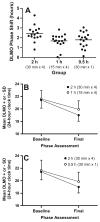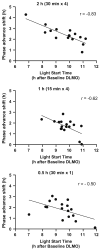Phase advancing human circadian rhythms with morning bright light, afternoon melatonin, and gradually shifted sleep: can we reduce morning bright-light duration?
- PMID: 25620199
- PMCID: PMC4344919
- DOI: 10.1016/j.sleep.2014.12.004
Phase advancing human circadian rhythms with morning bright light, afternoon melatonin, and gradually shifted sleep: can we reduce morning bright-light duration?
Abstract
Objective: Efficient treatments to phase-advance human circadian rhythms are needed to attenuate circadian misalignment and the associated negative health outcomes that accompany early-morning shift work, early school start times, jet lag, and delayed sleep phase disorder. This study compared three morning bright-light exposure patterns from a single light box (to mimic home treatment) in combination with afternoon melatonin.
Methods: Fifty adults (27 males) aged 25.9 ± 5.1 years participated. Sleep/dark was advanced 1 h/day for three treatment days. Participants took 0.5 mg of melatonin 5 h before the baseline bedtime on treatment day 1, and an hour earlier each treatment day. They were exposed to one of three bright-light (~5000 lux) patterns upon waking each morning: four 30-min exposures separated by 30 min of room light (2-h group), four 15-min exposures separated by 45 min of room light (1-h group), and one 30-min exposure (0.5-h group). Dim-light melatonin onsets (DLMOs) before and after treatment determined the phase advance.
Results: Compared to the 2-h group (phase shift = 2.4 ± 0.8 h), smaller phase-advance shifts were seen in the 1-h (1.7 ± 0.7 h) and 0.5-h (1.8 ± 0.8 h) groups. The 2-h pattern produced the largest phase advance; however, the single 30-min bright-light exposure was as effective as 1 h of bright light spread over 3.25 h, and it produced 75% of the phase shift observed with 2 h of bright light.
Conclusions: A 30-min morning bright-light exposure with afternoon melatonin is an efficient treatment to phase-advance human circadian rhythms.
Keywords: Bright light; Circadian misalignment; Circadian rhythms; DLMO; Jet lag; Melatonin.
Copyright © 2014 Elsevier B.V. All rights reserved.
Conflict of interest statement
The authors report no conflicts of interest. The authors alone are responsible for the content and writing of the paper.
Figures





Similar articles
-
Advancing human circadian rhythms with afternoon melatonin and morning intermittent bright light.J Clin Endocrinol Metab. 2006 Jan;91(1):54-9. doi: 10.1210/jc.2005-1009. Epub 2005 Nov 1. J Clin Endocrinol Metab. 2006. PMID: 16263827 Free PMC article. Clinical Trial.
-
Preflight adjustment to eastward travel: 3 days of advancing sleep with and without morning bright light.J Biol Rhythms. 2003 Aug;18(4):318-28. doi: 10.1177/0748730403253585. J Biol Rhythms. 2003. PMID: 12932084 Free PMC article. Clinical Trial.
-
Human Adolescent Phase Response Curves to Bright White Light.J Biol Rhythms. 2017 Aug;32(4):334-344. doi: 10.1177/0748730417713423. Epub 2017 Jun 26. J Biol Rhythms. 2017. PMID: 28651468 Free PMC article.
-
Melatonin marks circadian phase position and resets the endogenous circadian pacemaker in humans.Ciba Found Symp. 1995;183:303-17; discussion 317-21. doi: 10.1002/9780470514597.ch15. Ciba Found Symp. 1995. PMID: 7656692 Review.
-
Phase shifting the human circadian clock using melatonin.Behav Brain Res. 1996;73(1-2):131-4. doi: 10.1016/0166-4328(96)00084-8. Behav Brain Res. 1996. PMID: 8788490 Review.
Cited by
-
Current Considerations in the Diagnosis and Treatment of Circadian Rhythm Sleep-Wake Disorders in Children.Semin Pediatr Neurol. 2023 Dec;48:101091. doi: 10.1016/j.spen.2023.101091. Epub 2023 Oct 3. Semin Pediatr Neurol. 2023. PMID: 38065634 Free PMC article.
-
Circadian acclimatization of performance, sleep, and 6-sulfatoxymelatonin using multiple phase shifting stimuli.Front Endocrinol (Lausanne). 2022 Nov 16;13:964681. doi: 10.3389/fendo.2022.964681. eCollection 2022. Front Endocrinol (Lausanne). 2022. PMID: 36465660 Free PMC article. Clinical Trial.
-
Practice recommendations for the role of physiotherapy in the management of sleep disorders: the 2022 Brazilian Sleep Association Guidelines.Sleep Sci. 2022 Oct-Dec;15(4):515-573. doi: 10.5935/1984-0063.20220083. Sleep Sci. 2022. PMID: 36419815 Free PMC article. Review.
-
Classical conditioning for preserving the effects of short melatonin treatment in children with delayed sleep: a pilot study.Nat Sci Sleep. 2017 Mar 9;9:67-79. doi: 10.2147/NSS.S129203. eCollection 2017. Nat Sci Sleep. 2017. PMID: 28331380 Free PMC article.
-
Clock-Sleep Communication.Curr Mol Med. 2025;25(4):399-415. doi: 10.2174/0115665240305615240630113434. Curr Mol Med. 2025. PMID: 39694958 Review.
References
-
- Hampton SM, Morgan LM, Lawrence N, Anastasiadou T, Norris F, Deacon S, et al. Postprandial hormone and metabolic responses in simulated shift work. J Endocrinol. 1996;151:259–67. - PubMed
-
- Knutsson A. Health disorders of shift workers. Occupational Medicine. 2003;53:103–8. - PubMed
-
- Drake CL, Roehrs T, Richardson G, Walsh JK, Roth T. Shift work sleep disorder: prevalence and consequences beyond that of symptomatic day workers. Sleep. 2004;27:1453–62. - PubMed
Publication types
MeSH terms
Substances
Grants and funding
LinkOut - more resources
Full Text Sources
Other Literature Sources

